[original date 2005-03-24 06:39:39] The rough chart we constructed in part 1 shows the planets in approximately the positions they were in the sky.
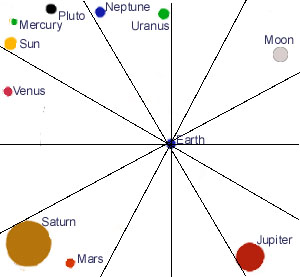
A rough chart
But it doesn’t allow us to state their positions precisely. Astrology is an old subject, it is thought the Sumerians divided the circle into 360 degrees around four and a half thousand years ago. 360 is a useful, divisible number and is close to the 365 days in a year. The invention of degrees will allow us to start pinpointing planetary positions more accurately.
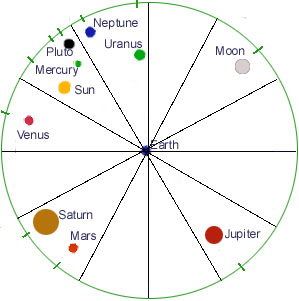
Circular chart
When planets move across the sky, they don’t simply move through degrees, they move against the background of the stars. From earliest times people have grouped the stars they saw into patterns we now call “constellations”. Even though we now know those stars may be at very different distances, constellations are still compelling patterns in the sky. There’s many constellations over the night sky, like Draco, the Dragon, right overhead in the northern hemisphere, but the most familiar ones are those located around the plane of the solar system – the zodiac constellations.
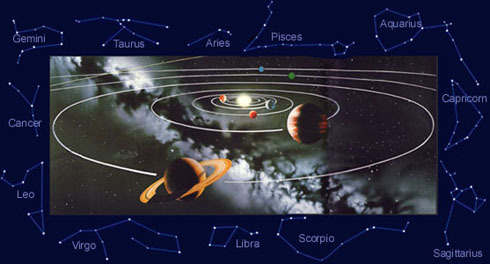
Zodiacal constellations
By marking these constellations around the edge of our chart we can easily divide up our chart into sections.

Chart with zodiac
But there is absolutely no universal consensus on how those positions are numbered or named! Where do we start numbering from? A circle has no beginning or end – so you can start anywhere at all! That’s what the different systems do.
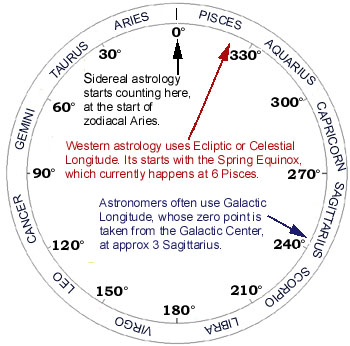
Three starting points
SIDEREAL ZODIAC
Jyotish uses the sidereal zodiac, which means it counts using the real constellations – sort of! Currently we use zero degrees Aries as the beginning of the zodiac; in past times it probably started at zero Taurus, Gemini or Cancer. However, the sidereal zodiac used in astrology is not in fact an exact mapping of the real constellations, although it’s a lot more accurate than the tropical zodiac.
The star maps shown here are not accurate to scale or position, but they do reflect the fact some constellations are bigger than others. Virgo, Scorpio and Pisces are larger than 30 degrees, Libra and Aries are smaller. So astrologers “tidy up” – they even them all out, creating 12 zodiac signs of 30 degrees each.
Because Aries is a small constellation and Pisces is a large one, the start of the sidereal zodiac, nominally 0 degrees Aries, is in fact in the end of the actual constellation Pisces.
There’s a debate about where exactly to start counting; the most common choice is the Lahiri system (“Lahiri ayanamsha”).
GALACTIC CO-ORDINATES
Astronomers often now use “galactic co-ordinates”, which count the degrees from the the galactic center. Radio-astronomy has established the center of our galaxy is in Sagittarius.
TROPICAL ZODIAC
Western astrology uses the “tropical zodiac”, which has a completely different way of calculating where to start counting. It does not start from any actual stars (even tidied-up ones). It uses the first day of spring as the start of the solar year, and projects that position in orbit out against the stars and calls it the zero point. This day is the spring (or “vernal”) equinox, when day and night are equal lengths.
Currently this point is at about 6 degrees of sideral Pisces.
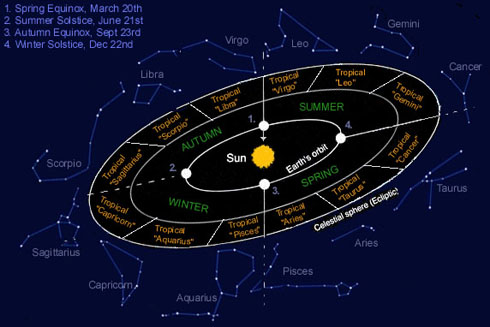
The tropical zodiac
On the first day of spring we can look to the east just before sunrise and see the constellation of Pisces, against which the sun will rise. Just to be really confusing, the tropical zodiac calls that the “Aries Point”. Then count off twelve sections of 30 degrees around the circle and call them by the names of the true zodiac constellations. You could call these “virtual constellations” as they don’t correspond to any actual constellations at all. The first 24 degrees of “tropical Aries” are in the constellation of Pisces; only the last 6 degrees are really in Aries.
So the tropical zodiac “signs” and starting point are defined by the earth’s relation to the sun, not it’s relation to the stars.There are two problems with this system:
1. Lots of people confuse tropical zodiac signs with real constellations.
2. The start point moves slowly but constantly.
Due to a very long-term cycle in the earth’s movement, the “Aries Point” moves by about 1 degree every 72 years. Over thousands of years each constellation in turn will be home to the this point. Around 200 AD the “Aries Point” was at zero degrees sidereal Aries, but it won’t be again for another, oh twenty-six thousand years or so. There is nothing wrong per se with the idea of a tropical zodiac; things would just be a lot simpler if it could be more easily distinguished from the sidereal zodiac.
PLANETARY POSITIONS ARE ALWAYS THE SAME
The position of the planets at any specific time are accurately described in all the systems – as long as you know which system is being used. In my natal chart, the planet Jupiter is at 2 degrees 08 minutes of sidereal Sagittarius. Or 26 degrees 03 minutes of tropical “Sagittarius”. Or approximately -1 degree or 359 degrees from the Galactic Center. They’re all describing the same position – Jupiter was almost conjunct the Galactic Center.
DO THE ZODIAC DIFFERENCES MATTER?
Early astrologers experienced different results as the planets moved through the zodiac constellations. The combination of planets positioned against the zodiac constellations is perhaps the most fundamental feature of astrology.
If you think the constellations themselves, or the powerful fixed stars within them – eg Regulus in Leo – are actually exerting or transmitting an influence on the planets then it matters that we represent these stars adequately. If you think the chief influences are planetary movements within the solar system, then the zodiac is just a picturesque way to describe planetary positions and inaccuracy is not significant. We’ll explore this issue in a future post.
